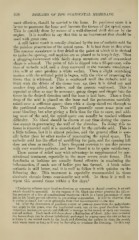Page 918 - My FlipBook
P. 918
928 DISEASES OF THE PERrDENTAL MEMBRANE. ;
most effective, should be carried to the bone. In persistent cases it is
better to penetrate the bone and lacerate the tissues of the apical space.
This is quickly done by means of a well-directed drill driven by the
engine. It is needless to say that this is an instrument that should be
used with great care.
A still better result is usually obtained by the use of carbolic acid for
the painless penetration of the apical space. It is best done in this wise:
The mucous membrane is first dried at the point at which it is desired
to make the opening, and napkins are so placed as to keep it dry. Then
a plugging-instrument with fairly sharp serrations and of convenient
shape is selected. The point of this is dipped into a 95-per-cent. solu-
tion of carbolic acid, and a drop conveyed to the mucous membrane
this will at once produce a white eschar. Then a slight scratching
motion with the serrated point is begun, with the view of removing the
tissue that is whitened. This is continued until the carbolic acid is
thick with the debris of the tissue torn up, then it is dried out and
another drop added, as before, and the process continued. This is
repeated as often as may be necessary, going deeper and deeper into the
tissue in the desired direction until the bone is laid bare. Then a fresh
drop of the acid is placed on the bone and the periosteum carefully
raised over a sufficient space ; then with a sharp chisel cut through to
the peridental membrane. This will generally cause some pain and
some bleeding, but after giving a little time for this to cease, and add-
ing more of the acid, the apical space can usually be reached without
difficulty. No blood should be drawn at any time during the opera-
tion except in penetrating the wall of the alveolus. In doing this no
tissue is removed until it is anaesthetized by the carbolic acid. This is
a little tedious, but it is almost painless, and the general effect is usu-
ally better than by other modes of penetrating the apical space. The
carbolic acid has the effect of modifying the pain, and the opening left
does not close so readily. I have frequent occasion to use this process
with very sensitive patients, and have found it to be quite satisfactory.
These means of relief may with advantage be supplemented by con-
stitutional treatment, especially in the more severe acute forms. Hot
foot-baths at bedtime are usually found effective in combating the
inflammation, if made use of before pus has formed. A brisk saline
cathartic is still better, and it is well to follow it with quinine on the
following day. This treatment is especially recommended in those
obstinate chronic forms occasionally met WMth. In those it is well to
repeat this several times within a few days.^
^ Exclusive reliance upon local medication, so common in dental practice, is an evil
which slionld be amended. At the request of Dr. Black the writer presents the lollow-
ing summary of a line of constitutional treatment which in a large percentage of cases
has in his hands proved effective in preventing suppuration. It will be observed that
it varies in detail, but not in principle, from that recommended in the text.
1st. After the evacuation of purulent matter or {)ent-up gases from the pulp-cham-
ber, apply to the gums, over the implicated tooth, one or two good Swedish leeches.
American leeches are unruly and difHcult to manage in the mouth or upon any circum-
scribed surface. Each leech will draw about a fluidrachm of blood. After theirremoval
the hemorrhage can be almost indefinitely prolonged by wiping away the clot as fast as
it forms in the wound made by the leech aud directing the patient to rinse the mouth
with warm water as long as it may be desirable to continue the bleeding. In this way


